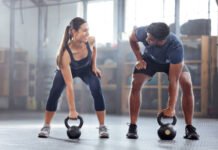Lifting weights is an excellent way to build muscle, burn fat, and improve overall physical fitness. However, weightlifting can also be dangerous if not done correctly. One way to prevent injury while weightlifting is to use a lifting belt. But when is the right time to start using one?
What is a lifting belt?
A lifting belt, also known as a weightlifting belt or powerlifting belt, is a thick, sturdy belt worn around the waist during weightlifting exercises. The purpose of the belt is to provide support and stability to the lower back and abdominal muscles during heavy lifting. A lifting belt is typically made of leather or nylon and fastens with a buckle or Velcro.
Why use a lifting belt?
A lifting belt can provide several benefits during weightlifting exercises. One of the primary benefits of a lifting belt is increased intra-abdominal pressure. When you wear a lifting belt, it increases the pressure in your abdomen, which stabilizes your spine and reduces the risk of injury. The belt also provides support to your lower back muscles, which can help prevent strains and sprains.
Another benefit of using a lifting belt is increased lifting performance. The added support and stability provided by the belt can allow you to lift heavier weights with better form, which can lead to increased strength gains over time.
When to start using a lifting belt?
So, when should you start using a lifting belt? The answer to this question is not cut and dry, as it depends on a few factors. Here are a few things to consider when deciding if and when to start using a lifting belt:
Experience level
Beginner weightlifters may not need to use a lifting belt right away. If you are just starting out with weightlifting, it’s essential to focus on proper form and technique first. As you progress and start lifting heavier weights, you may consider using a lifting belt to provide extra support and stability.
Weightlifting Goals
Your weightlifting goals can also play a role in when to start using a lifting belt. If you are training for strength and powerlifting competitions, you may want to start using a lifting belt earlier on in your training. If you are lifting for general fitness or bodybuilding purposes, you may not need to use a belt as often or at all.
Lift Intensity
The intensity of your lifts can also help determine when to start using a lifting belt. If you are lifting light to moderate weights, a lifting belt may not be necessary. However, if you are regularly lifting near or at your maximum weight, a lifting belt can provide added support and safety.
Body Composition
Your body composition can also play a role in when to start using a lifting belt. If you have a history of back pain or injury, or if you have a weak core, a lifting belt may be beneficial earlier on in your training. Additionally, if you have a larger midsection, a lifting belt may be more comfortable and provide better support.
How to use a lifting belt?
If you’ve decided to start using a lifting belt, it’s essential to use it correctly to get the most benefit. Here are a few tips for using a lifting belt:
Positioning: The lifting belt should sit comfortably around your waist, with the buckle or Velcro in the front. The back of the belt should be positioned just above your hip bones, and the front should be slightly lower.
Tightness: The lifting belt should be tight enough to provide support but not so tight that it restricts your breathing or movement. You should be able to fit two fingers between the belt and your body.
Breathing: To get the most benefit from the lifting belt, it’s essential to use the proper breathing technique. Take a deep breath into your diaphragm and hold it as you begin the lift. Exhale as you complete the lift. This helps increase intra-abdominal pressure and provides added support to your core muscles.
Type of Lift: It’s essential to consider the type of lift you are performing when using a lifting belt. A lifting belt is most beneficial during exercises that involve heavy lifting, such as squats, deadlifts, and overhead presses. It may not be necessary for exercises that involve lighter weights, such as bicep curls or tricep extensions.
Gradual Progression: It’s also essential to gradually progress with your use of a lifting belt. Start by using the belt for your heaviest lifts and gradually increase the weight and frequency of use over time. This allows your core muscles to continue to develop and strengthen without relying solely on the support of the lifting belt.
Alternatives to Lifting Belt
While lifting belts can provide added support and stability during weightlifting exercises, they are not always necessary. If you prefer not to use a lifting belt, there are a few alternatives you can try:
Bracing: Bracing is a technique that involves taking a deep breath and holding it to increase intra-abdominal pressure during heavy lifts. This can provide similar benefits to using a lifting belt without the need for additional equipment.
Core Strengthening Exercises: Incorporating exercises that strengthen your core muscles, such as planks and Russian twists, can also help provide added support and stability during heavy lifting.
Conclusion
In summary, there is no set rule for when to start using a lifting belt. It depends on your experience level, weightlifting goals, lift intensity, body composition, and personal preference. If you decide to use a lifting belt, it’s essential to use it correctly and gradually progress with its use. Remember, a lifting belt is not a substitute for proper form and technique. Always prioritize form and technique first, and use a lifting belt as an additional tool to help prevent injury and improve performance.



